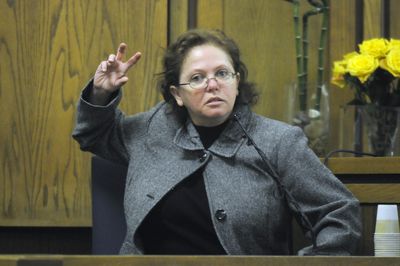Prosecutors close case against Stark
Murder defendant controlled combative marriage, they say

Shellye L. Stark testified last week about a marriage she described as marred by abuse. Prosecutors used a piece of that testimony Tuesday as a foundation for their closing arguments in her murder trial.
Stark herself told the jury she and her husband “ ‘had mastered destroying each other,’ ” Spokane County Deputy Prosecutor Larry Haskell said Tuesday.
The question the jurors must answer is who was the aggressor in a relationship both sides acknowledge was unhealthy: Shellye Stark or Dale Robert Stark, whom she shot to death Dec. 9, 2007, in what she says was self-defense.
Describing the Starks’ marriage as “mutual combat,” Haskell contended that Shellye Stark was the one in control, and that when her control began to slip as the marriage unraveled, she developed a plan after moving to California to be with her boyfriend, Brian Moore.
“Ultimately, that plan ended with the execution of Mr. Stark,” Haskell said.
Defense lawyer Russell Bradshaw told jurors the evidence doesn’t support that claim, pointing to Spokane police Detective Kip Hollenbeck as the instigator of an investigation that failed to examine all the facts.
He said there’s no evidence that Stark staged the shooting scene at 1620 S. Maple St., as was alleged.
Detective Brian Hamond told jurors the .357-caliber revolver used in the shooting appeared to have been placed near Dale Stark’s body. He said a knife and onion on the kitchen counter, with no other food around, seemed staged.
Stark has said she was chopping onions two days before the killing when she rushed out of the home to see her sister, Karen Jachetta, in the hospital.
Jachetta had hit a moose while driving to Spokane from her Priest River, Idaho, home to give weapons to her sister.
The gun was set down instead of thrown because Stark waited until a 911 dispatcher instructed her to set it down, Bradshaw said.
“She did what she was told,” Bradshaw said.
Bradshaw contested the prosecution’s argument that Stark shot her husband in the back, although forensics showed the man suffered three bullet wounds to the back.
Stark said last week that she had just started pulling the trigger when Dale Stark reached for a knife and threatened to kill her, but that she hadn’t intended to kill him.
“His back was turned as he was advancing,” Bradshaw said, emphasizing that Dale Stark was left-handed and would have turned to grab the knife as he charged his wife.
“He wasn’t coming over to give her a hug,” Bradshaw said.
The defense said the shooting was an overreaction to a death threat by Dale Stark. But they pointed to key details from their client when arguing the overreaction was caused by years of abuse: Dale Stark was angry at Shellye for the restraining order, his face had reddened and he’d cursed and threatened her just as he had during past beatings.
Those are trauma triggers indicative of battered woman syndrome, which a Florida-based psychologist said provoked Shellye Stark’s overreaction.
Haskell noted last week that there was no reference to marital abuse in Stark’s interview with Hollenbeck.
But Bradshaw urged the jurors to put themselves in Shellye Stark’s shoes and imagine the years of abuse she described.
A lack of corroborating evidence to her claims is common in domestic violence cases, experts on both sides have acknowledged.
“Broad corroboration is a luxury Ms. Stark could not afford, because the price of broad corroboration, the price of opening that door, was her life,” Bradshaw said.
Jury deliberations begin again this morning.